Tiangong-2 Space Laboratory
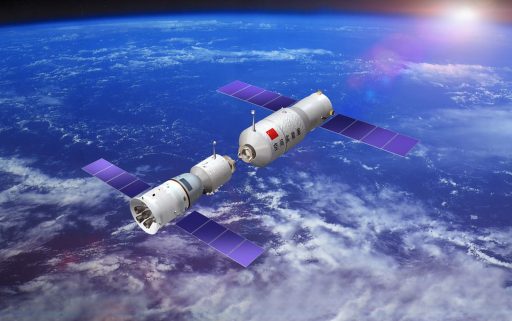
Tiangong-2 is a Chinese Space Laboratory representing the second stepping stone by the China National Space Agency on a path to establishing a modular space station toward the beginning of the next decade.
Tiangong translates literally to ‘Heavenly Palace’ and is China’s first space station program which, in its early stages, is not unlike the early Salyut space stations and the American Skylab – launched with equipment and supplies for a finite mission duration already on board and not serviced by cargo resupply vehicles.
China’s first Heavenly Palace arrived in orbit in late September 2011 after a flawless launch atop a Long March 2F rocket. Orbiting Earth over 300 Kilometers in altitude, Tiangong was first visited two months after launch when the uncrewed Shenzhou-8 spacecraft completed China’s first automatic docking in space.
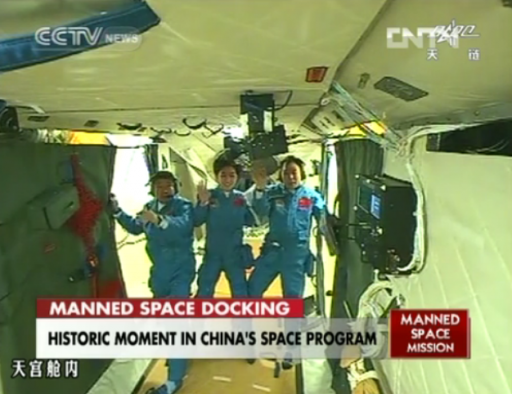
Shenzhou 9, with a crew of three including China’s first woman in space, launched on June 16, 2012 and completed a two-day link-up with the space laboratory for a stay of ten days. In the middle of its mission, the spacecraft was undocked and flew out to a distance from Tiangong-1 to then demonstrate China’s first rendezvous and docking in manual control. Shenzhou 9 landed in Inner Mongolia after a successful 13-day mission.
Tiangong’s next visiting crew, again comprised of two men and one woman, launched on June 11, 2013 with docking two days after liftoff. The Shenzhou-10 mission made use of lessons learned on China’s first space station mission, replacing internal panels and cladding on Tiangong-1 to make crew translation easier. Shenzhou-10 returned to Earth after 15 days, making it China’s longest Space Mission at the time.
Originally, Tiangong-1 was built for a two-year service life and was to be deorbited shortly after the Shenzhou 10 mission, however, the Manned Space Engineering Office decided to keep the laboratory in orbit to continue operating its Earth Observation payload and collect data of key systems over an extended flight. Orbital maintenance maneuvers continued in 2014 and apparently ceased in late 2015.
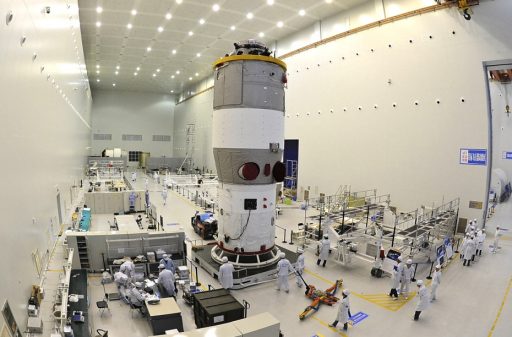
The current status of the Tiangong-1 space lab (September 2016) is uncertain. Comments made by Chinese officials in March 2016 indicate that ‘data services’ have been ended and that the space laboratory would be under constant monitoring before re-entering the atmosphere. These statements were taken as confirmation that Tiangong-1 would make an uncontrolled destructive re-entry around two years after its last orbital maintenance maneuver.
Tiangong-2 is another stepping stone to long-duration missions on a large modular Space Station planned by China in the early 2020s. It will continue pushing the record for China’s longest crewed mission and will participate in the demonstration of on-orbit cargo delivery – a necessity for the operation of a long-duration space station.
The Tiangong-2 spacecraft, in its structure, is identical to its sibling, Tiangong-1, however, it has a larger payload capacity and its interior makes use of lessons learned during the initial space lab mission to make habitation easier.
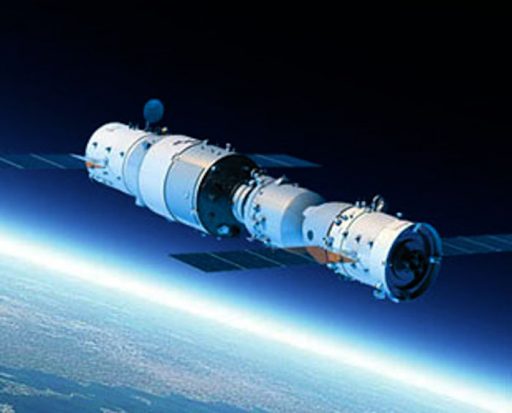
The Tiangong-2 spacecraft makes use of knowledge from the Chinese Shenzhou crewed spacecraft but incorporates a number of new components. It is comprised of three sections: A Service Module in the aft hosting the propulsion and power generation systems, a Transfer Module and the Habitation and Orbital Module.
Overall, Tiangong-2 measures 10.4 meters in length and its Orbital Module is 3.35 meters in diameter while the Service Module has a reduced diameter of 2.8 meters hosting a pair of power-generating solar arrays with a deployed span of 17 meters. The space lab module has a launch mass of approximately 8,500 Kilogram, limited by the capacity of the Long March 2F rocket.
Inside the Orbital Module, crews have a total habitable volume of 15 cubic meters. The vehicle hosts a life support system and onboard resources have been sized for a 20-day mission by a three-person crew. However, in a late change, the crew was reduced to two in order to permit a 30-day stay aboard the spacecraft to significantly push China’s spaceflight record.
Service Module
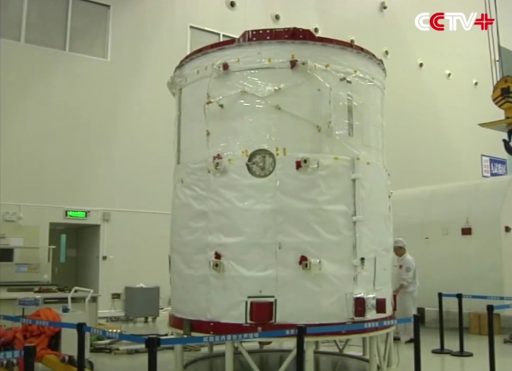
The Tiangong-2 Service Module is around 3.3 meters long and 2.8 meters in diameter and hosts the major support systems of the spacecraft including Electrical Power System and Propulsion. Tiangong-2 features an orbit control system comprised of a pair of 490 Newton engines with extensive flight heritage on different missions including China’s lunar exploration efforts. The two engines are used for orbital maintenance maneuvers and the setup of proper phasing for the rendezvous with Shenzhou. Eight small vernier jets are available for orbital-fine tuning maneuvers.
The Propulsion System hosts four spherical tanks that, according to reports, are similar to the Shenzhou spacecraft. If that is the case, each tank can hold 230 liters of propellant giving Tiangong a capacity of 1,000 Kilograms of Monomethylhydrazine fuel and Nitrogen Tetroxide oxidizer.
Attitude Control is provided by a series of low-thrust engines. Pitch and Yaw control is accomplished with four pairs of thrusters while roll control and fine translation uses eight thrusters on the base of the Service Module.
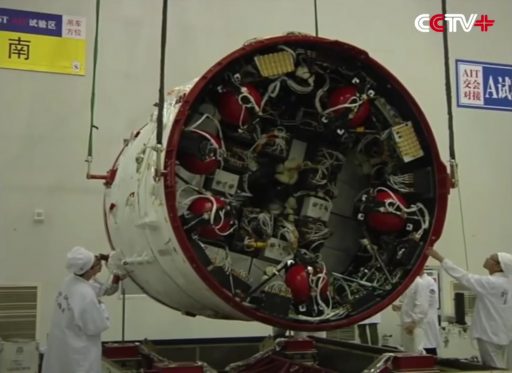
Tiangong-2 primarily relies on stellar navigation, employing redundant Star Trackers to collect imagery of the star-filled sky that is then compared to an onboard catalog of bright star constellations from which the spacecraft’s precise three-axis attitude can be calculated. An Inertial Measurement System is employed during attitude maneuvers and rate damping; and sun sensors act as backup attitude measurement device for spacecraft safe modes.
The two solar array wings of the Tiangong spacecraft each consist of four panels with a total area of over 32 square meters. The triple-junction Gallium-Arsenide cells deliver a peak power of 6,000 Watts, the orbital average is 2,500 Watts. Solar aspect sensors on the arrays are used to determine the solar incidence angle to allow the Solar Array Drive Mechanism to position the arrays for optimized power generation.
Power is stored in 40 Amp-hour Nickel-Metal-Hybrid batteries and Tiangong-2 uses a 100-Volt main bus that is carefully maintained between 98-103V. Central DC/DC converters supply secondary bus voltages of 28 and 12-Volts to power different subsystems.

The data system of the Tiangong-2 spacecraft makes use of the 1553 standard for internal transmission of commands and housekeeping data as well as payload data. Communications use S-Band for the relay of telemetry and crew voice transmissions while a Ku-Band system is used for the downlink of high-data rate communications that include multiple video feeds from the interior and exterior of the spacecraft.
The Service Module is joined to the Orbital Module via Transfer Section a little over one meter in length and conical in shape to transition from the 2.8-meter Service Module diameter to the 3.35-meter diameter of the Orbital Module. The space in this section is likely utilized to house tanks for the environmental control system holding pressurized Oxygen and Air for atmospheric maintenance aboard the spacecraft plus water tanks for consumption by the crew.
Orbital Module
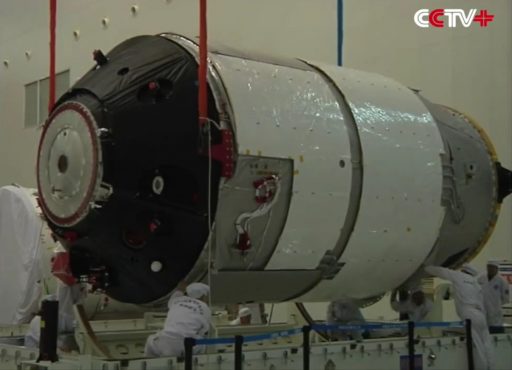
The Orbital Module is around five meters long and offers 15 cubic meters of habitable volume for the crew because a large potion of the internal space is occupied by experimental and support systems which mostly reside in the aft section of the module. On the exterior of the orbital module is a large radiator that expels over 2kW of heat generated in the Service and Orbital Modules and transported to the radiator via heat pipes.
The Tiangong-1 Orbital Module featured a two-color paint scheme to represent the ground and sky and so help crew members get their bearings aboard the spacecraft when trying to locate equipment. Also inside the module are a number of high-resolution video cameras permitting ground controllers to follow the crew’s activities on board.
Tiangong hosts two sleep stations, a third crew member would typically sleep inside the docked Shenzhou spacecraft but due to the crew reduction for Shenzhou 11 both crew members will be able to stay aboard Tiangong.
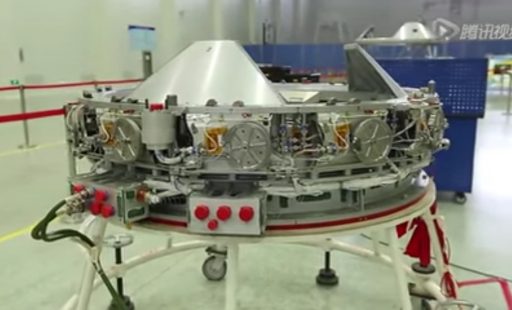
The front end of the Orbital Module hosts an APAS-type docking mechanism with a 1.4-meter diameter. APAS stands for Androgynous Peripheral Attach System and similar systems were used in the Apollo Soyuz Test Project as well as Space Shuttle Missions to the Mir Space Station and ISS. Unlike the Probe and Cone Mechanism employed by Soyuz, APAS hosts two identical docking mechanisms on each spacecraft which can allow any APAS docking ring to mate with any other APAS ring.
For each docking, one APAS system is configured to be in active operation (typically that on the chaser) while the other is in passive mode with its docking ring retracted. The ring holding alignment guides shifts at the moment of contact to align the latches on the active unit with the catches on the passive side to establish a soft dock. After relative motion has dissipated, the two rings are tightly pulled together by retracting the ring on the active side and securing the coupling via 12 locking pins to form a pressure-tight seal.
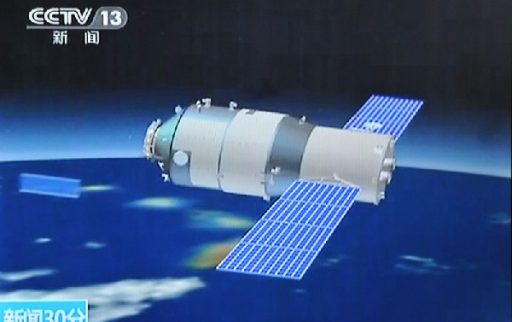
The Tiangong-Shenzhou architecture employs a rendezvous system comprised of several sensors to guide the active spacecraft, Shenzhou, to the Tiangong space lab that fulfills the passive role. A long-range UHF radar system acquires the vehicle to begin the relative navigation phase of the rendezvous at around 50 Kilometers out. Communications between the two spacecraft are established to exchange navigation data and help the two find each other in space.
At closer range, the spacecraft switch to a laser-based system for range and range rate measurement and an electro-optical navigation system to deliver information on the relative geometry between the vehicles. The rendezvous includes hold points at 5 Kilometers, 400 meters and finally 140 meters from where final approach is initiated. Ground commanding is only performed as necessary and the vehicles employ a complex logic that allows them to automatically determine whether their status is within allowable parameters for each stage of the rendezvous.
Docking occurs at a relative speed of 0.2 meters per second and the lateral error has to be under 18 centimeters to accomplish a safe soft-docking.
Robotic Arm
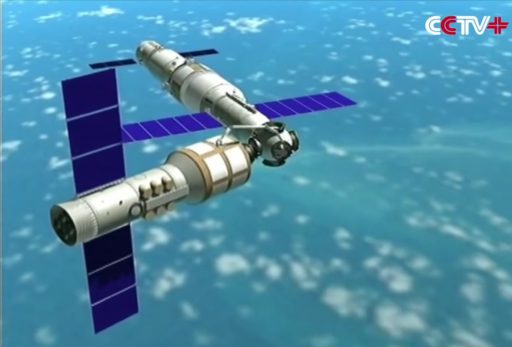
The most significant addition to Tiangong-2 is a robotic arm developed by the China Academy of Space Technology (CAST) to undergo testing in the actual space environment to prepare for operational use of the technology on China’s modular space station. Called the Chinese Space Station Manipulator system (CSSM), the seven-jointed arm measures 10.5 meters in length and will ultimately be able to carry 25 metric tons.
The application of the CSSM on China’s modular space station will be similar to that of Canadarm2 on the International Space Station. During the assembly of the complex, new modules will complete a docking to an axial port before being grappled by the arm to be moved to radial docking ports. Visiting Vehicle captures and support of spacewalk activities are also on the task list for the robotic arm and so will be the installation and retrieval of external science payloads.
When operational on China’s future station, the remote manipulator system will consist of two arms, the 10.5-meter Core Space Station Cabin Manipulator and a smaller Experimental Space Station Cabin Manipulator that will be 5.5 meters long. The two will either work together as a combined system or independent of one another.
In-Space Cargo Delivery
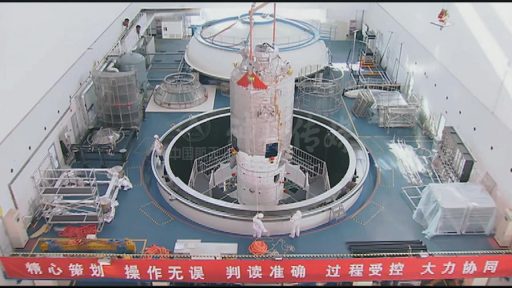
For the operation of China’s future space station, a capability for cargo delivery and in-orbit refueling has to be developed. Resupply needs of the large modular station will be satisfied by the Tianzhou (Heavenly Vessel) cargo spacecraft that, in design, is closely based on the Tiangong-1/2 modules featuring some modifications to be able to carry a large amount of cargo.
Tianzhou measures ten meters in length and is 3.35 meters in diameter with a launch mass of approximately 13,500 Kilograms including up to six metric tons of cargo. Because of its large mass, Tianzhou requires the more-powerful Long March 7 rocket to place it into orbit.
The launch of the Tianzhou-1 cargo mission is expected to occur in April 2017 from the Wenchang Satellite Launch Center on Hainan Island, marking only the second mission of the CZ-7 rocket after it made its debut in June 2016.
Because Tiangong-2 only has a single docking port, only one vehicle can be present at a time, meaning that no crew will be onboard for the cargo mission demonstration and hatches between the two spacecraft will remain closed. However, there was an evaluation of a potential mission design in which a crew member remained on Tiangong to welcome & unload the cargo vessel while the rest of the crew is parked at a convenient distance aboard Shenzhou for a later re-docking.
In addition to verifying the overall mission architecture of future Tianzhou missions, the debut flight will demonstrate the transfer of propellant through the docking interface and into the tanks of Tiangong-2. China has conducted previous research into fluid dynamics in orbit to learn how to transfer a large quantity of liquid from one vessel to another, but the verification of fuel transfer capability is essential on the path to a long-duration space station.
Experiments
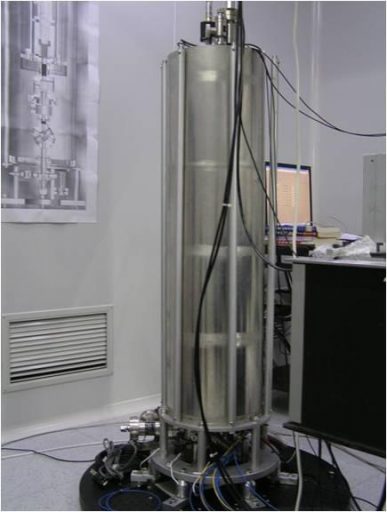
Very much like the Tiangong-1 mission, TG-2 will be outfitted with a combination of internal and external payloads. While most of the internal experiments require a crew to perform them, the external payloads can be used as an Earth-imaging capability to add to China’s vast fleet of Earth observers from a unique non-synchronous orbit. Science projects underway onboard include space biology, fluid physics, Earth science, space astronomy and space environment.
Tiangong-2 deploys to space the first-ever Cold Atomic Fountain Clock which has a higher stability and precision than conventional atomic clocks, keeping a precision of better than one nanosecond over a period of more than one week. The fountain clock will make use of the Ramsey method of measuring the frequency of atomic transitions.
A group of atoms, typically Caesium or Mercury, are subjected to laser radiation from all angles in an optical trap, causing the atoms to move closer together and almost stop vibrating – cooling down to a temperature just a fraction of a degree over absolute zero.
Then, the atoms are exposed to an electromagnetic field, followed by a wait time and exposing the cloud to the field again ahead of the measurement of the fraction of atoms that have made the transition to a higher energy level as a result of the RF input. Ultimately, the frequency can be adjusted so that all electrons change energy levels corresponding to the period of one SI second.
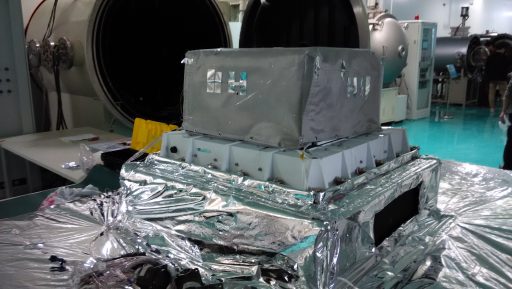
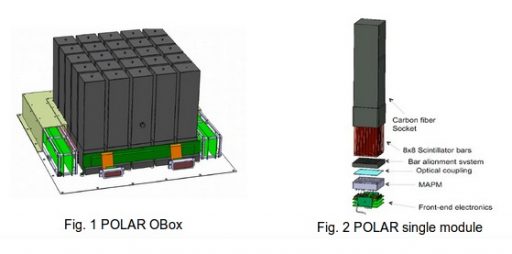
An international detector aboard Tiangong-2 is POLAR, developed in China, Switzerland and Poland. The Gamma-ray Burst Polarimeter―POLAR is a highly-sensitive detector dedicated to the measurement of Gamma Ray Burst (GRB) polarization though a large effective detection area and wide field of view, enabling the instrument to capture transient sources such as GRBs. Measurement of gamma-ray polarization will lead to a better understanding of its radiation region geometry and emission mechanisms.
Gamma-ray bursts have only been known for six decades and are still an interesting object of study since the production mechanism of powerful GRBs in the universe is largely unknown. For the validation of existing models, a precise measurement of GRB polarization is of utmost importance. However, GRBs are rate events occurring in random location of the sky, making their measurement a difficult undertaking. To date, unambiguous measurement of GRB polarization are not available to an extent that would allow for in-depth analysis.
POLAR is comprised of 25 modules each consisting of 64 scintillator bars (6 x 6 x 176 millimeters) coupled to multi-anode photomultipliers and read-out electronics. Incoming gamma-ray photons in an energy range of 50 to 500 kilo-Electronvolt undergo Compton Scattering in the low-Z scintillator material and generate a modulation pattern traced in subsequent detector modules.
The instrument has a field of view of ±70 by ±70 degrees, covering around one third of the sky. Overall, POLAR has a mass of 32 Kilograms and measures 45 by 45 by 25 centimeters in size. POLAR makes no attempt to localize the location of GRBs in the sky, though powerful events can be localized with sufficient precision.
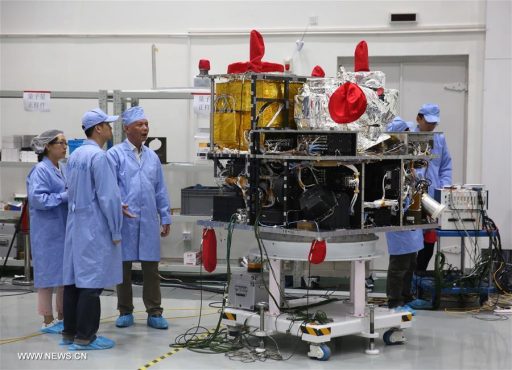
Tiangong-2 also continues development in the field of Quantum Communications which was lifted to a new level when the world’s first experiment Quantum Communications Satellite was launched by China in 2016. Aboard Tiangong is a space-to-ground quantum key communications experiment consisting of a quantum key generator and laser communications package.
Quantum Information Science is an emerging field driven by fascinating physics and many promising applications such as high-speed quantum computers and ultra-secure quantum communications. Quantum Key Distribution, the exchange of cryptographic keys between two parties, is completed by means of correlated, or entangled photons – particles of light. The operators of the system share an encryption key encoded in the polarization of a string of entangled photons.
This communication between two parties is inherently secure because any attempt to eavesdrop on or tamper with the system would cause the quantum state of the entangled photons to collapse, immediately making the presence of a third party known to the rightful operators of the system.
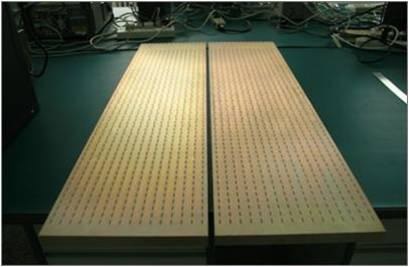
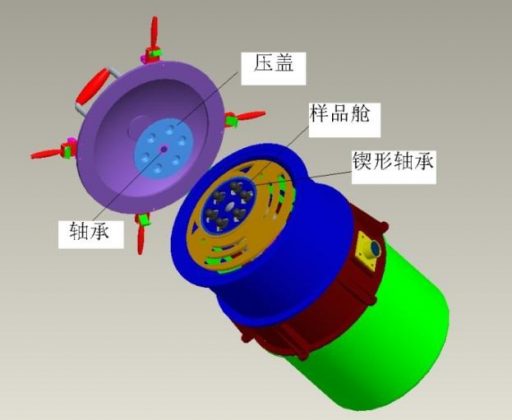
The perfect security of quantum communications makes this technology attractive to national security entities and in some way, establishing reliable long-distance quantum communications represents the space race of the 21st century.
The Earth observation payload on Tiangong-2 is comprised of a series of detectors – a microwave altimeter, multi-angle wide field imager for land and ocean observations, and a multi-spectral limb imaging spectrometer for atmospheric research.
Flying inside the Tiangong-2 spacecraft is a diverse range of experiments. A Plant Cultivation Unit will enable plants to be grown in space to determine the effects of the space environment to plant germination and growth properties.
Also aboard the spacecraft is an experiment looking at complex liquid-bridge thermocapillary convection processes in the absence of gravity-driven phenomena.
An Integrated Material Furnace will be in use for several materials science experiments.
Heating and melting samples of metal alloys or other materials in a zero-G environment followed by the solidification of the sample yields a very pure material without any contaminations. The study of the solidification process and the finished product can provide valuable knowledge concerning the properties of the material that could improve production techniques on Earth for better material properties in alloys, glass and ceramics.
Banxin-2
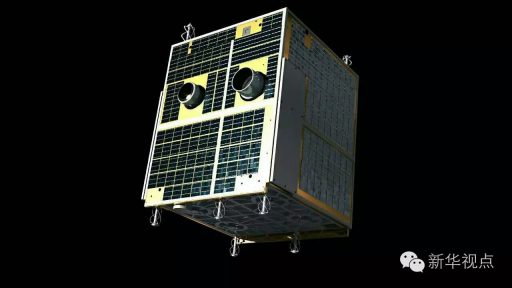
Riding piggyback on the Tiangong-2 space laboratory is Banxing-2 (BX-2), a microsatellite developed by the Shanghai Academy of Spaceflight Technology. Like its predecessor that flew on the Shenzhou 7 mission, the companion satellite will be tasked with the collection of photos of the Tiangong-2 spacecraft.
The box-shaped satellite with a side length around 40 centimeters is outfitted with three GaAs solar panels for power generation, a precise attitude determination and control system and an ammonia-based propulsion system for proximity-flying with Tiangong-2. BX-2 carries a series of visible light cameras including a 25 Megapixel camera and wide-angle imagers to collect photos of the space laboratory in orbit.
